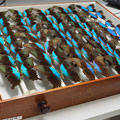What amino acids in shells can tell us about Bronze Age people
Posted on 19 June 2014
A Nucella (common dog whelk) shell together with one of the beads the researchers believe may be created from this or a closely related species (top) and an Antalis (tusk) shell together with the bead the research team believe is cut from a shell like this (bottom). Credit: Dr Sonia O’Connor.The research team used amino acid racemisation analysis (a technique used previously mainly for dating artefacts), light microscopy, scanning electron microscopy and Raman spectroscopy, to identify the raw materials used to make beads in a complex necklace discovered at an Early Bronze Age burial site at Great Cornard in Suffolk, UK.
They discovered that Bronze Age craftspeople used species like dog whelk and tusk shells, both of which were likely to have been sourced and worked locally, to fashion tiny disc-shaped beads in the necklace. The research is published in PLOS ONE.
The researchers included archaeologists, mathematicians, chemists and physicists, the latter from the BioArCh and York Centre for Complex Systems Analysis (YCCSA) and the Departments of Archaeology, Mathematics, Chemistry and Physics at the University of York. Dr Sonia O’Connor, of the University of Bradford’s Department of Archaeological Sciences, carried out the light and electron microscopy, and prehistoric jewellery specialist Dr Alison Sheridan, of National Museums Scotland, facilitated access to the Great Cornard necklace, which had been excavated by Suffolk Archaeology.
When it was first realised that the tiny white beads had been made from shell, the question arose as to its source. Had the shell been obtained locally or did it originate from a species from further afield, perhaps even the Mediterranean thorny oyster (Spondylus)? The Mediterranean thorny oyster is a shell of long-standing symbolic and cultural significance which is known to have been used on the Continent around the time when the Great Cornard necklace was made.
But this collaborative research, led by Dr Beatrice Demarchi, of York’s Department of Archaeology and BioArCh, and Dr Julie Wilson, of the Departments of Chemistry and Mathematics and YCCSA, has shown this not to be the case, and has suggested an alternative possibility.
Dr Demarchi said: “Dog whelks and tusk shells were likely to be available locally so these people did not have to travel far to get hold of the raw materials for their beads.
“There is evidence, from elsewhere in Britain and further afield, for the use of tusk shells at various times in the past. This may well be because they are relatively easy to work and their hollow shape is very distinctive.”
Dr Wilson added: “The statistical analysis used pattern recognition algorithms for taxonomic identification, comparing the composition of the beads with a large database of shell amino acid compositions. Although we cannot know the origin of the beads for certain, our multidisciplinary approach provides additional evidence for the identifications.”
This research was possible thanks to funding from the EU FP7 Re(In)tegration grant PERG07-GA-2010-268429 (project: mAARiTIME) and the AHRC/EPSRC Science and Heritage programme, Award AH/H032150/1(Project: Cultural Objects Worked in Skeletal Hard Tissues), with contributions from NERC, the Wellcome Trust, the Leverhume Trust and English Heritage for amino acid analyses, and the Brazilian funding councils CAPES and CNPq for Raman spectroscopy. The team is grateful to all the collaborators who, throughout the years, have submitted their shell samples for analysis at the NEaar laboratory, allowing the amino acid database to be developed.
Further information:
- The paper ‘An Integrated Approach to the Taxonomic Identification of Prehistoric Shell Ornaments’ is published online by PLOS ONE. http://dx.plos.org/10.1371/journal.pone.0099839
- For more information about the University of York’s Department of Archaeology, please visit http://www.york.ac.uk/archaeology/
- For more information about the University of York’s Department of Chemistry, please visit http://www.york.ac.uk/chemistry/
- For more information about the University of York’s Department of Mathematics, please visit http://maths.york.ac.uk/www/Home
- For more information about BioArCh, please visit http://www.york.ac.uk/archaeology/centres-facilites/bioarch/
- For more information about York Centre for Complex Systems Analysis, please visit http://www.york.ac.uk/yccsa/
- For more information about the NERC-recognised amino acid facility, NEaar, please visit http://www.neaar.co.uk/
Explore more news

New funding for scientists developing robotic assistance in breast screening
Tuesday 4 November 2025

New research reveals human cost of Ministry of Defence Afghan data leak
Wednesday 29 October 2025

Integrating museum records with contemporary citizen science data to uncover 166 years of tropical butterfly history
Wednesday 29 October 2025

Class, race, ageism and status shaping who stays in general practice, study shows
Wednesday 29 October 2025

New research explores how indoor plants can improve human health and our environment
Friday 24 October 2025
